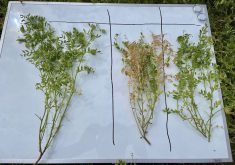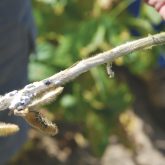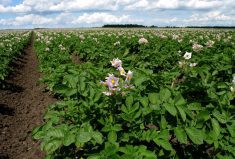Weed science is constantly evolving and adapting as it learns more about the basic interactions of crops and weeds in the field. Now, get ready for another evolutionary rethink.
Early in 2014, Dr. Clarence Swanton, a professor and researcher with the department of plant agriculture at the University of Guelph, brought to light new research indicating corn and soybean plants are capable of sensing another plant species nearby, setting in motion a series of cellular reactions, including a loss of anthocyanins and an overproduction of hydrogen peroxide, which degrades cell membranes and damages DNA.
Some 20 years prior to this find, Swanton revolutionized weed science with the discovery of a “critical weed-free period,” a stage in the growing season defined as V2 to V6 (four to 10 leaf-tips) in corn and up to and including the first to third trifoliate in soybeans.

Recently, Swanton published another intriguing study showing that corn seeds detect the quality of the light that penetrates below the soil surface. What’s more, the quality of this light may let the crop know about the presence of plants (i.e. weeds) above ground.
On top of that, thiamethoxam, a common insecticidal seed treatment, can affect germination by altering how much gibberellin (GA) and abscisic acid (ABA) is generated according to the quality of that light.
It all sounds very scientific, which it is. But it also sounds like it may pave the way for some exciting new approaches to weed control.
The known
It’s a research project that dovetails with previous work by Swanton, and then updates it. This particular project was done entirely in the lab and, at present, there’s no intention of moving it outside. It was carried out only to confirm the hypotheses about light quality and interactions, and the subsequent effect of a seed treatment.
Read Also

Sensing the soil: Root cell research finds ‘stress hormone’
Research into how root cells react to soil stressors could help plants better adapt to changes in their climate.
Swanton’s latest research is contained in a manuscript that was submitted in July 2014 and accepted for peer-reviewed publication this past November. Its abstract cites some of the factors involved in the study that have become standards in weed science. For one, red and far-red light wavelengths can penetrate an inch down into the soil and delay germination in a seed through a series of cellular interactions.
 Penetration is determined by soil type, particle size, and moisture content, as well as by the wavelength of the light, with far-red wavelengths penetrating the deepest, particularly in sandy soils. Another component in the abstract states that thiamethoxam, applied as a seed treatment, can enhance germination but that no previous work on its effect on buried corn seed when germinating in the presence of above-ground weeds has been done.
Penetration is determined by soil type, particle size, and moisture content, as well as by the wavelength of the light, with far-red wavelengths penetrating the deepest, particularly in sandy soils. Another component in the abstract states that thiamethoxam, applied as a seed treatment, can enhance germination but that no previous work on its effect on buried corn seed when germinating in the presence of above-ground weeds has been done.
“We hypothesized that the changes in red:far-red (light) reflected from above-ground weeds would be detected by (corn) seed phytochrome and delay seed germination by decreasing the level of GA and increasing ABA,” says the report’s abstract. “We further hypothesized that thiamethoxam would overcome this delay in germination.”
“This is kind of like the ‘start clean and stay clean’ principle,” says Swanton. “Our scenario here is that this is the first time that anyone has reported that corn seed can detect above-ground activity. Now this whole story happens at a shallow level, but what is neat from the other studies is that we’ve actually sampled the emerging seedling, and tried to detect some of the changing physiology within that emerging seedling.”
All of this counters the notion that plants are simple organisms, with Swanton adding that they’re learning that plants are in an almost constant state of change, responding to these complex chemical, cellular, and even molecular processes. This latest research confirms that a buried corn seed is actually detecting before it emerges above, which means it’s already preparing its physiology to address the situation above-ground.
“The idea that a plant could lose yield potential by the minute based on some of our work changes one perspective — it makes you pay attention to weed control, rather than delay it,” says Swanton. “But what this does is really provides the science behind the idea that early weed control is important along with the concept of ‘start-clean, stay-clean,’ because those things we do as a rule of thumb.”
It’s worth noting that thiamethoxam is a neonicotinoid insecticidal seed treatment. That it might offer some added benefit, over and above the current furor concerning the potential impact on bee health, and the proposed ban on its use by the Ontario government, was not part of the rationale behind the research. Instead, it was an observation concerning germination, similar to other serendipitous discoveries like the use of fungicides as growth regulators. That a fungicide could increase yield by delaying maturity might not have been part of its initial mandate. Yet that segment of the chemical industry has augmented the delay-maturity-to-increase-yield benefit that fungicides bring.
“Suddenly now, some of this relatively newer chemistry has some of these benefits,” says Swanton. “And that’s why we went to thiamethoxam, because with the far-red effect, we were seeing all of these negative impacts on a plant, and then they were talking about how they could boost seedling development.”
Swanton then approached representatives of Syngenta, the manufacturer of thiamethoxam used in the company’s Cruiser formulations, and asked if they’d be interested in his research, to which they consented. Growth from five petri dishes containing five seeds and replicated five times were analyzed according to the percentage of seed germinated and radicle root length. Corn seeds were harvested at six, 12, 24, 36 and 48 hours.
“It was on my own initiative. Nobody paid us to do this,” says Swanton. “We had a hypothesis about why we thought the seed treatment would work, and we tested for it. And at the very end, whether it’s neonicotinoid insecticides or not, it shows a principle. It suddenly opens up the whole idea that a seed treatment could be a gene trigger, and that’s what’s really significant about it.”
Rather than thinking about seed treatments only as an insect and disease issue, Swanton might be able to explore other types of chemistries in an effort to determine whether they also have triggering effects. That work could then open up a whole new perspective on chemical uses and applications.
“And that’s what I think is the most exciting aspect — the fact that you could put some chemical on a seed and thereby trigger some of these genes to actually protect the plant against stress,” Swanton says.
The light penetration effect in corn may also apply to soybeans, and Swanton refers to a thesis being written by one of his MSc students, HaeWon Kim. She’s been working with potted soybeans and examining the effect of potted weeds placed beside the soybeans. That level of proximity on its own is sufficient to adversely affect nodulation, says Swanton. Kim is also scheduled to present her findings later this year to the Weed Science Society of America.
Granted, this is a lot of information to disseminate in the course of a little more than a year, yet Swanton is confident that growers can benefit from the overall message. He’s shared his report with Syngenta, as well as a gathering of the Innovative Farmers Association of Ontario just before Christmas 2014. The message is simple.
“This is something that evidence confirms, so this is why you want to reduce your risk to management and this is how we propose you do it,” says Swanton.
Of ratios and wavelengths
It’s known that seed germination is affected by an inverse relationship in the levels of gibberellins (GA) and abscisic acid (ABA) with higher levels of GA desired for germination. Where the ratio of red to far-red (R:FR) light influences this process is that with a high R:FR, phytochrome, a photoreceptor in the plant cells detects light and affects the level of GA biosynthesis. An increase in the level of GA causes the destruction of DELLA repressor proteins. By contrast, a low R:FR ratio will lead to an accumulation of DELLA proteins, repressing GA responses and increasing the presence of ABA, effectively blocking germination.
Another relationship affected by GA and ABA is in the expression and activity of alpha- and beta-amylase enzymes. These enzymes break down starch into simple sugars, creating an energy source that’s readily available for seed germination.
Again, with a high R:RF ratio, GA increases and the production of both alpha- and beta-amylases is enhanced. But under a low R:RF ratio, GA decreases, ABA increases and amylase production is blocked, subsequently suppressing germination.
















